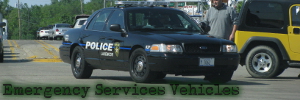















Blaring Air Horns |
|---|

|
Gus Philpott
Woodstock Advocate
December 19, 2008
What is the proper use of an air horn on a paramedics ambulance or a fire truck?
Yesterday afternoon while I was fueling the bug at the Clark station on Lake Avenue, I heard a siren and then an air horn. Looking toward Route 47 I could see an emergency vehicle navigating the intersection and then coming toward Kimball on Lake Avenue.
The driver of the vehicle, Woodstock Fire Rescue District No. 53, then used the air horn excessively as it approached Kimball Street.
It seems to me that the air horn is to be used "as needed" and cautiously. Its purpose is to alert drivers, not bully them.
The first rule of operating a vehicle that is using emergency equipment is to drive safely. Speed is a secondary factor. If the vehicle becomes involved in a crash, the few seconds saved by "pressing on" are lost, because the emergency vehicle won't get to its call and another vehicle will have to be dispatched.
Air horns should be used infrequently and for short bursts. If the driver can't get through, he can't get through. Sometimes, drivers of emergency vehicles have to enter an oncoming lane at an intersection. This is one of the most dangerous maneuvers, because oncoming drivers may be surprised.
If you drive with your driver's window cracked open at the top, you'll have a much better chance of hearing a siren sooner, rather than later. When you hear the siren, figure out where it's coming from. Is the emergency vehicle approaching you from behind, from the front or the side?
Are there times when emergency lights and siren should not be used at all? Sometimes their use creates problems that would not otherwise exist.
An example is when a paramedic's vehicle is enroute to Memorial Medical Center on U.S. 14 and there are no eastbound vehicles in front of it. Are lights and siren needed? No. That's NO. And, when there is heavy traffic in both directions, sometimes the driver should turn off the lights and siren, because he'll arrive faster in the normal flow of traffic than by playing dodge-'em in two lanes of traffic.
When lights and siren are used unnecessarily, westbound traffic stops because drivers don't understand Illinois law. They stop in the traffic lane, rather than only slowing and moving to the right side of the lane. It is not necessary for them to stop, unless for the safe passage of the emergency vehicle. When the emergency vehicle has a clear lane, there is no requirement for westbound traffic to stop. The danger is from the absent-minded, distracted driver who then runs up on a slowing or stopped car and pulls suddenly around it, right into the path of the eastbound emergency vehicle.
When drivers hear air horns less often, they are more likely to pay closer attention to them, improving the safety of all.
